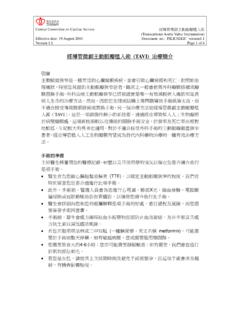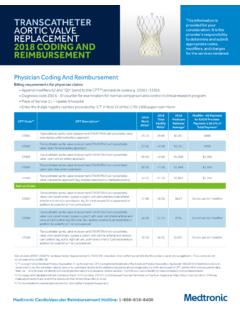Transcription of Measuring the risk in valve patients Lessons learnt …
1 Measuring the risk in valve patients Lessons learnt from the tavi story? Bernard Iung Bichat Hospital, Paris, France Faculty disclosure Bernard Iung I disclose the following financial relationships: Consultant for Abbott, Boehringer Ingelheim, Valtech Paid speaker for Edwards Lifesciences Management of severe aortic stenosis Severe AS Symptoms LVEF < 50% No Physically active No Presence of risk factors and low/intermediate individual surgical risk No Yes Re-evaluate in 6 months AVR AVR or tavi No Yes Symptoms or fall in blood pressure below baseline No Contraindication for AVR No Yes Short life expectancy No tavi Yes Med Rx High risk for AVR Exercise test No Yes Yes Yes Yes European Heart Journal 2012 - & European Journal of Cardio-Thoracic Surgery 2012 - ).
2 Contraindication for surgery (Partner B) 358 patients Logistic Euroscore: 28% STS score: 12% (Leon et al. N Engl J Med 2010;363:1597-607) High risk for surgery, but operable (Partner A) 699 patients Logistic Euroscore: 29% STS score: 12% (Smith et al. N Engl J Med 2011;364:2187-98) Risk scores and contraindication for surgery Risk scores in valve surgery Good discrimination (low vs. high risk) C-index But poor calibration (predicted vs. observed risk) Euroscore II improved calibration, but no specific data in high-risk patients (Nashef et al. Eur J Cardiothorac Surg 2012;41:734-45) (Dewey et al. JTCS 2008;135:180-7 (Brown et al.))
3 JTCS 2008;136:566-71) EuroSCORE I and II: external validation Good discrimination (c-index ) Better calibration than Euroscore I only for low and intermediate risks (Barili et al. Eur Heart J 2013;34:22-9) EuroSCORE II: validation in valvular diseases PREDICTED MORTALITY (%)OBSERVED MORTALITY (%)01020300102030 Euroscore 1 Euroscore 2 2931 consecutive patients operated on for valvular surgery in Bichat Hospital during a 5-year period 30-day mortality: c-index= , p(HL) < c-index= , p(HL) = (Bouleti et al. ESC 2013) Euroscore 1 Euroscore 2 239 patients operated on for valvular surgery with Euroscore I 20% (mean 35 16) 30-day mortality : 25% PREDICTED MORTALITY (%)OBSERVED MORTALITY (%)01020304050600102030405060 Euroscore 1 Euroscore 2 c-index= , p(HL)= c-index= , p(HL)= EuroSCORE II: validation in valvular diseases (Bouleti et al.
4 ESC 2013) Euroscore and tavi 250 patients treated with tavi Mean age 83 7 years 190 transfemoral, 60 transapical 30-day mortality c-index ES I ES II STS (Durand et al. Am J Cardiol 2013;111:891-7) Risk Score for tavi France 2 registry (01 Jan 2010 - 31 Dec 2011) 3933 patients in 34 centres Exclusion of 100 patients (missing procedure data or valve -in- valve ) 3833 patients Random sampling Derivation cohort: 2552 patients Validation cohort: 1281 patients 382 deaths at 30 days or in hospital (10%) (Iung et al. Heart 2014;100:1016-23) Adjusted odds-ratio [95% CI] p Points for score Age (years) < 90 90 1 [ ] 0 1 Body mass index 30 < 1 [ ] [ ] 0 1 3 NYHA class IV [ ] 2 2 acute pulmonary edemas last year [ ] 2 Pulmonary hypertension (sPAP 60 mmHg) [ ] 1 Critical state (Euroscore) [ ] 3 Respiratory insufficiency [ ] 2 Dialysis [ ] 4 Approach Transfemoral or subclavian Transapical Other 1 [ ] [ ] < 0 2 3 Predictive model and score Prediction and Calibration Score 30-Day Mortality C-index Derivation cohort [ ] Validation cohort [ ] Calibration (Predicted vs.
5 Observed Mortality) Frailty in patients with aortic stenosis Prevalence in patients undergoing tavi 25% in a multicentre Canadian series of 339 patients (Rod s-Cabau et al. J Am Coll Cardiol 2010;55:1080-90) 17% in the tavi German Registry (697 patients ) (Zahn et al. Eur Heart J 2011, 32:198-204) 23% in the Partner B Cohort (358 patients ) (Leon et al. N Engl J Med 2010;363:1597-607) Impact of indices of functional performance / frailty Karnofsy index was predictive of 30-day MACCE/death (Buellesfeld et al. Eur Heart J 2010:31:984-91) Independent predictor of 5-year survival (Rodes Cabau et al. J Am Coll Cardiol 2012;60:1864-75) 152 patients aged 70 undergoing CABG and/or valve surgery (mean Euroscore I ) 37 (24%) in-hospital mortality or major morbidity (STS) Discrimination (c-index) Euroscore I STS PROM STS PROMM C-index of STS PROMM increased from to when adding: Nagi scale 5-meter gait speed Impact of Frailty / Diasability Indices (Afilalo et al.
6 Circ Cardiovasc Qual Outcomes 2012;5:222-8) 2137 patients from the PARTNER trial/registry 6-month poor outcome (death or impaires Qol as assessed by the Kansas city Cardiomyopathy Questionnaire) 33% poor outcome at 6 months 10 predictive factors, inclusding MMSE and 6-min walk test Discrimination (c-index) Derivation sample Validation sample Impact of Frailty / Diasbility Indices (Arnold et al. Circulation 2014;129:2682-90) Indications for transcatheter aortic valve implantation Class Level tavi should only be undertaken with a multidisciplinary heart team including cardiologists and cardiac surgeons and other specialists if necessary.
7 I C tavi should only be performed in hospitals with cardiac surgery on-site. I C tavi is indicated in patients with severe symptomatic AS who are not suitable for AVR as assessed by a heart team and who are likely to gain improvement in their quality of life and to have a life expectancy of more than 1 year after consideration of their comorbidities. I B tavi should be considered in high risk patients with severe symptomatic AS who may still be suitable for surgery, but in whom tavi is favoured by a heart team based on the individual risk profile and anatomic suitability. IIa B European Heart Journal 2012 - & European Journal of Cardio-Thoracic Surgery 2012 - ).
8 In the absence of a perfect quantitative score, the risk assessment should mostly rely on the clinical judgement of the heart team , in addition to the combination of scores. High Surgical Risk? Decision between tavi and AVR? EuroScore 20% STS score > 10% Fraility Chest radiation Porcelain aorta Re-operation Risk-stratification faces limitations when applied to tavi . This is mainly due to a moderate discrimination of predictive models of short and mid-term outcome. The same findings apply to valvular surgery when performed in high-risk patients . No score threshold can be used to reliably identify patients who will not benefit from tavi . The inclusion of indices of cognitive or functional capacity may improve the performance of future scores.
9 Current guidelines therefore privilege the heart team approach in decision-making. Conclusion Frailty A syndrome of decreased reserve and resistance to stressors, resulting from multiple declines across multiple physiologic systems leading to vulnerability to adverse outcomes 3 criteria among: weakness, weight loss, exhaustion, low physical activity, and slowed walking speed (Fried et al. J Gerontol A Biol Sci Med Sci 2001;56:M146-56) Katz index of independence A Independent in feeding, continence, transferring, toileting, dressing, and bathing B Independent in all but one of these functions C Independent in all but bathing and one additional function D Independent in all but bathing, dressing, and one additional function E Independent in all but bathing, dressing, toileting, and one additional function F Independent in all but bathing, dressing, toileting, transferring, and one additional function G Dependent in all six functions (Katz et al.)
10 JAMA 1963;185:914-919. ) Refining clinical indications for tavi patients who are not candidates to any intervention Poor expected life expectancy / QoL Need for better identification (improved risk scores, assessment of comorbidities, functional and psychometric ) tavi in patients at low(er) risk for AVR Concerns on durability, residual AR Comparative evaluation with the results of AVR (randomised trials) Impact of comorbidities on life expectancy Causes of death (30 days to 1 Year) in the Source Registry 1038 patients ( tavi using Sapien valve ) Half of deaths were of non-cardiac cause (Thomas et al. Circulation 2011;124:425-33) ALL 179 Cardiac 45 ( ) Heart Failure 28 ( ) Myocardial Infarction 6 ( ) Endocarditis 3 ( ) Other* 8 ( ) Non Cardiac 88 ( ) Pulmonary** 21 ( ) Renal Failure 11 ( ) Cancer 10 ( ) Stroke 9 ( ) Gastrointestinal 5 ( ) Other** 32 ( ) Unknown 46 ( ) Sudden Death 18 ( ) Unknown 18 ( ) Other 10 ( ) Intermediate- and low-risk patients At the present stage, tavi should not be performed in patients at intermediate risk for surgery and trials are required in this population.



